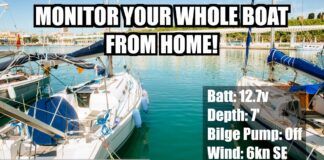Photo by Drew Frye

We filled our water tanks (40 and 72 gallons) in May, and now the water is brackish, brown. Have you done a study on purifying water or tanks? Bleach is one remedy, but I wondered whether PS has ever done an article on this subject?
Richard Olney III
1990 Hood Little Harbor 42
Manchester, Mass.
Weve not yet tested products for water treatment, although that is on our radar for the near future. In past reports, we did look at water filters, including a December 1998 test and our Chandlery article on the Nature Pure QC2 in this issue. In your case, wed recommend sanitizing your tanks and hoses first, rather than starting with a water filter or purifier.
Most boat owners use hydrogen peroxide, a bleach-water solution, or a bleach-detergent-water solution. Some shy away from using bleach in aluminum water tanks because chlorine (bleach) is corrosive in large amounts. However, its effects are cumulative, so if youre only using it on an occasional basis, it should be fine. (Annual freshwater-tank cleaning is recommended, or semi-annual in especially warm climates.) Rubber and neoprene water-pump parts are also vulnerable to damage when exposed to a lot of chlorine.
To sanitize your tanks, try the following procedure, which we gleaned from marine sanitation guru Peggy Hall, author of Get Rid of Boat Odors: A Guide to Marine Sanitation Systems and Other Sources of Aggravation and Odor.
If the tank has a clean out/inspection port, look for anything that may be trapped around the baffle plates and the tank bottom. Swab away as much of this residue as possible.
Then, to prep the system for cleaning, be sure to remove any filter cartridges or aerators at the sink faucet(s). If you have a water heater, turn it off at the electrical panel. Then, flush the system with potable water and drain it completely through each faucet.
For cleaning, mix a chlorine-water solution using a quarter-cup (2 ounces) of Clorox or Purex household bleach per gallon of water; use one gallon of solution for each 5 gallons of tank capacity. Then pour the mixture into the empty tanks, and fill them the rest of the way with potable water.
Run water from each faucet or outlet until air has been released and the entire system is filled. You will know when its filled because you will be able to smell bleach from the faucets. Do not turn off the water pump; it must remain on to keep the system pressurized and the solution in the lines. Leave the system pressurized with the bleach solution in it for at least three hours, but not more than 24 hours.
After the waiting period, drain the water through every faucet and shower head on the boat. (Its a good idea to remove any diffusion screens from the faucets at this point, because the gunk thats likely to come out could cause a clog.) Fill the tank with fresh water only, and drain it again through each outlet. Clean and reinstall the aerators at the faucets. Then fill your tanks with fresh water as you normally would.
If the water has an excessive chlorine taste or odor, mix a solution of one quart white vinegar to five gallons water, pour it into each tank, and allow it to agitate in the tanks for a few days-either by rocking the boat dockside or going for a sail or two. Drain and flush the tanks with potable water again, just as before.
If you want to take your tank re-commissioning a step further, consider replacing the soft water-delivery hoses, which tend to absorb bacteria.
Remember, in the U.S. (and most other developed nations), the molds, fungi, and bacteria in onboard water systems are unpleasant, but these are usually just an aesthetics issue, not a water-purity issue, Hall reminded us. Unless youre using well-water, the water supply has already been purified.






































Small point, but her name is Peggie Hall, not Peggy Hall. You should correct that out of respect.
We use her procedure to sanitize our water tank every spring and it works very well.